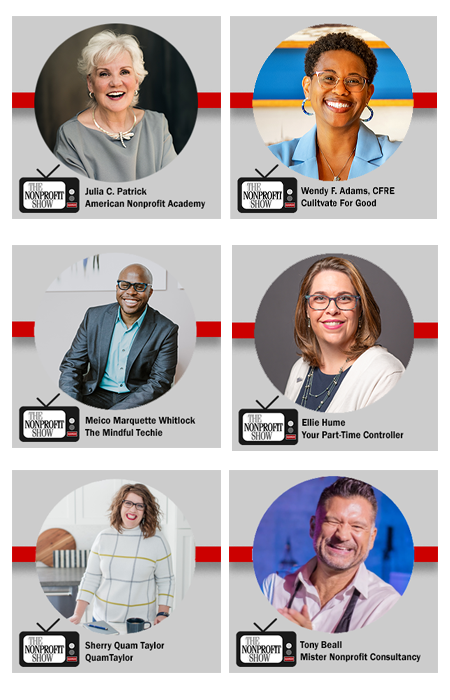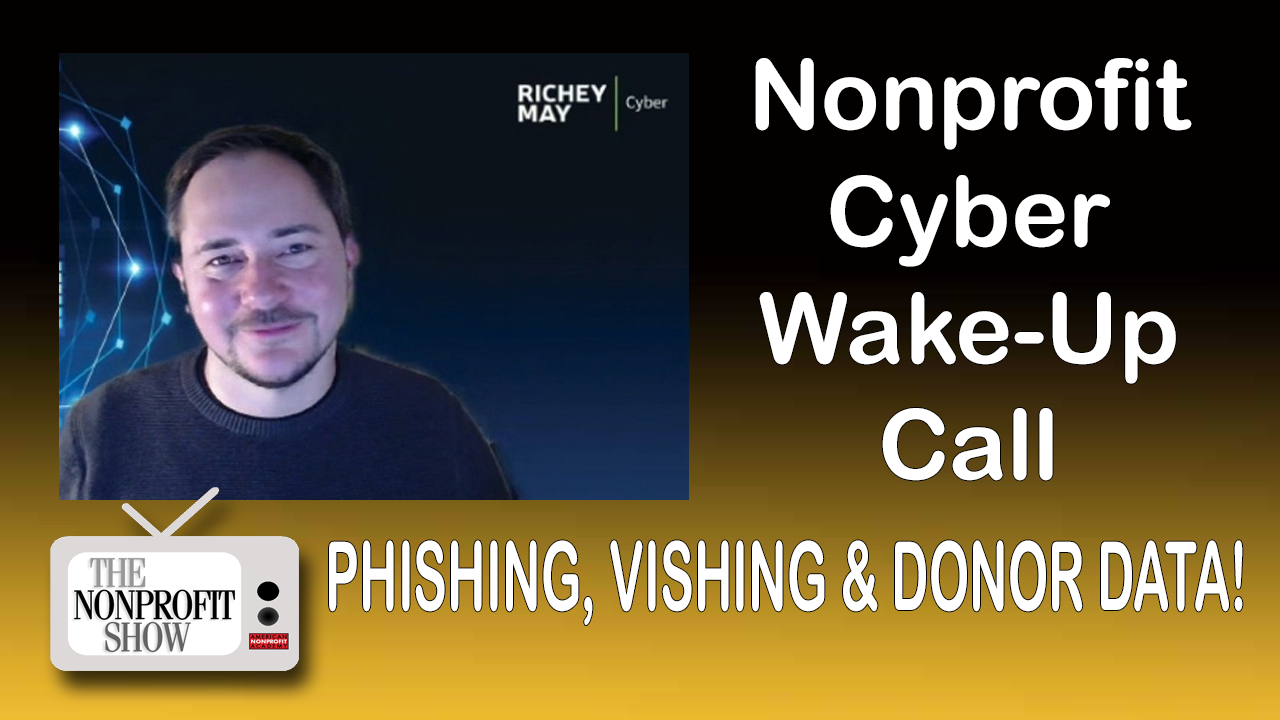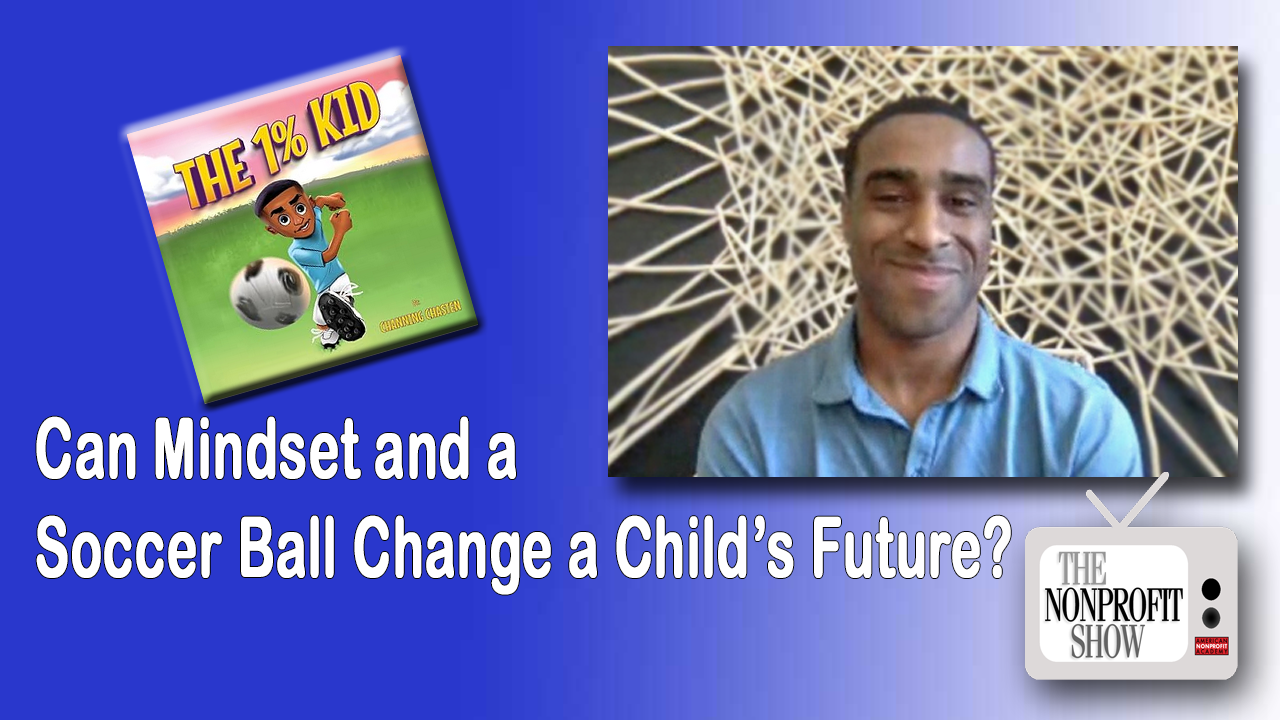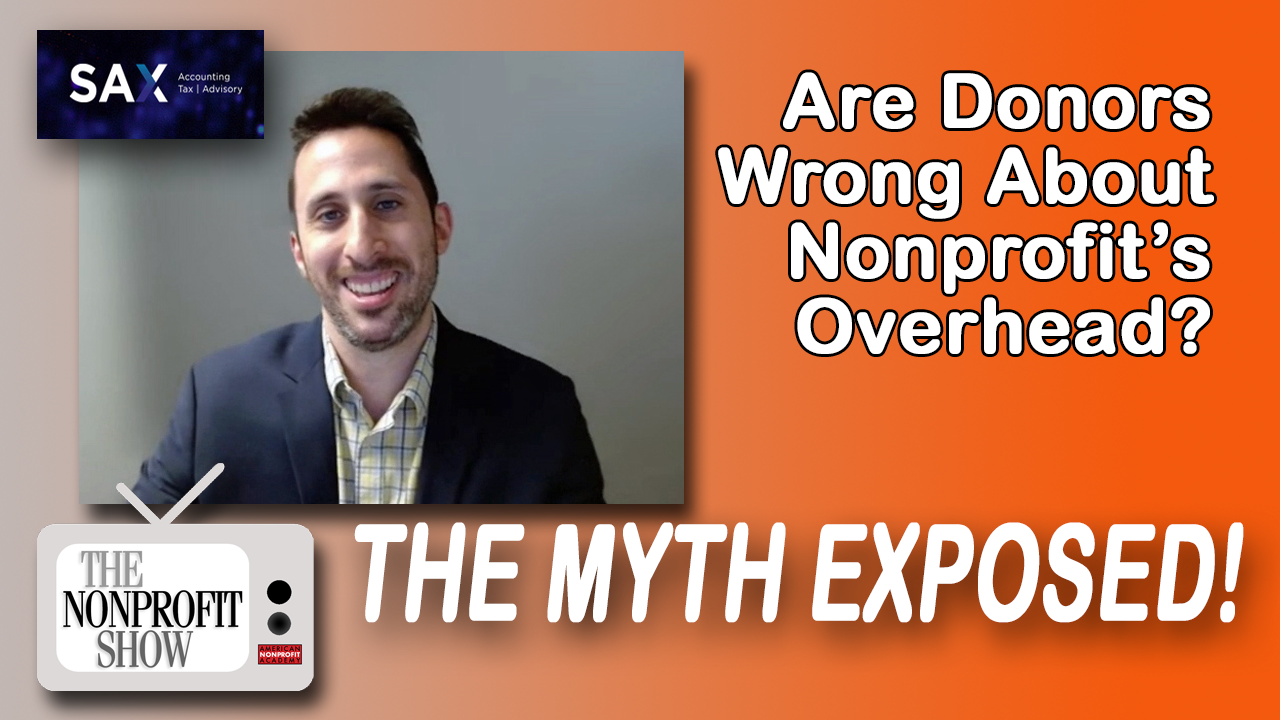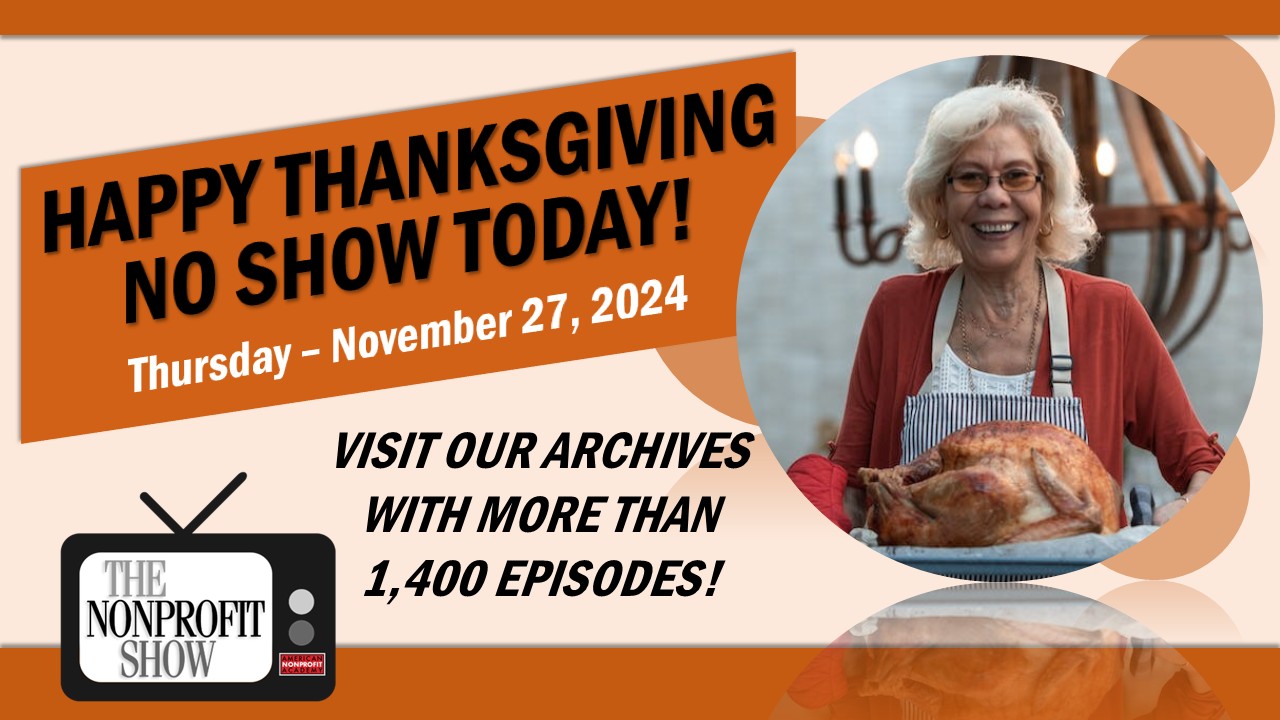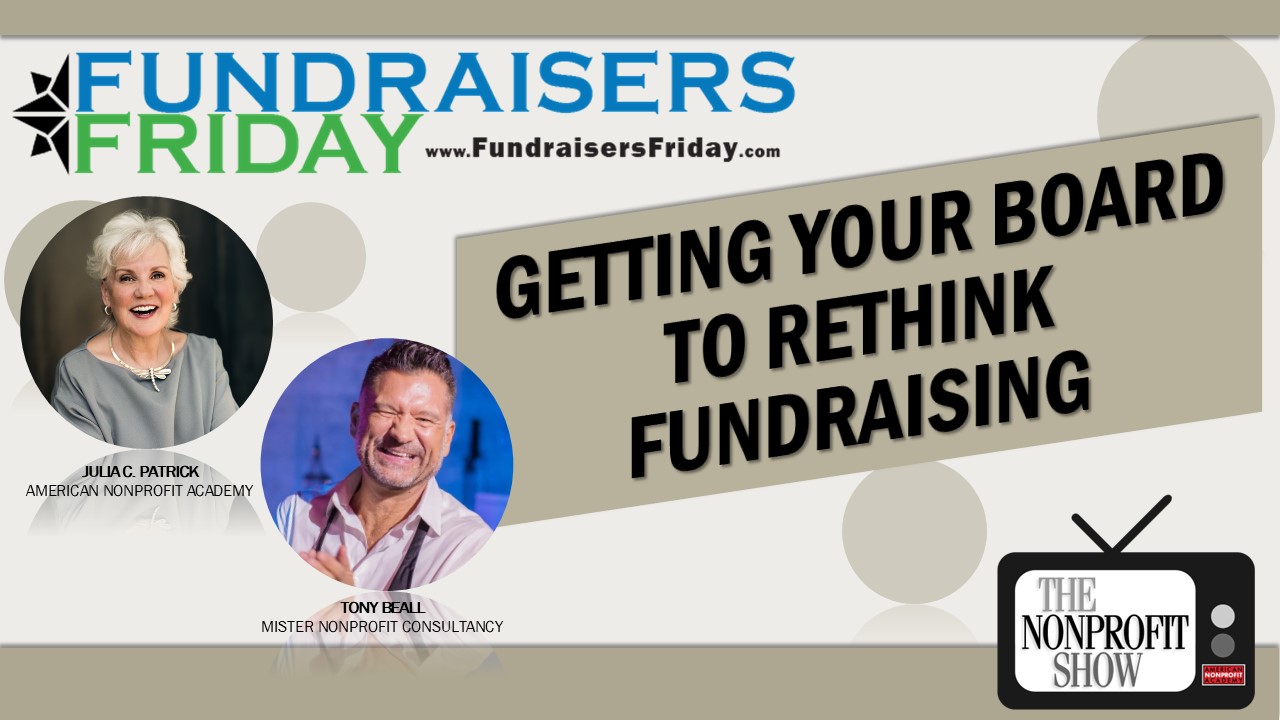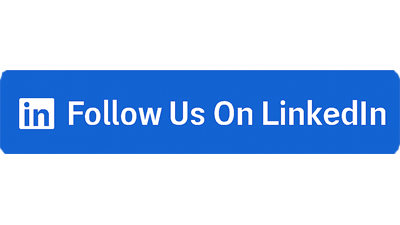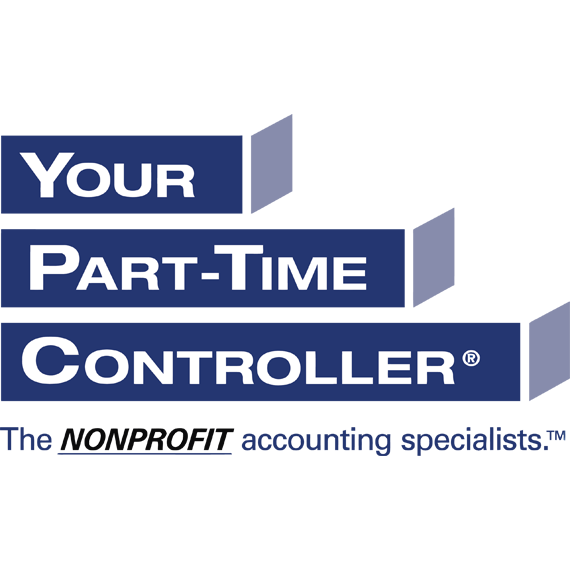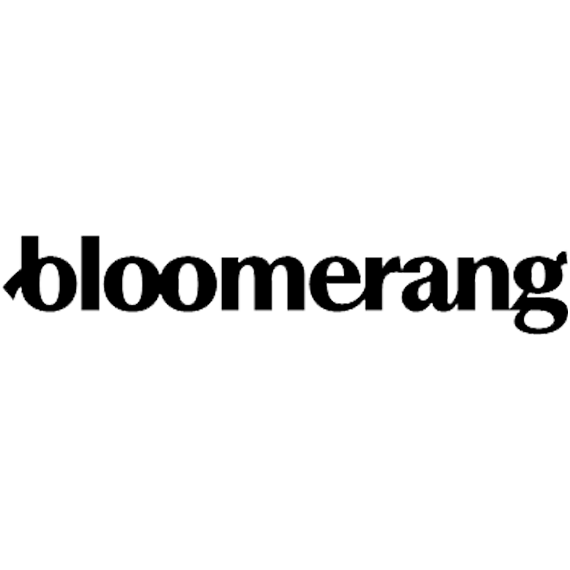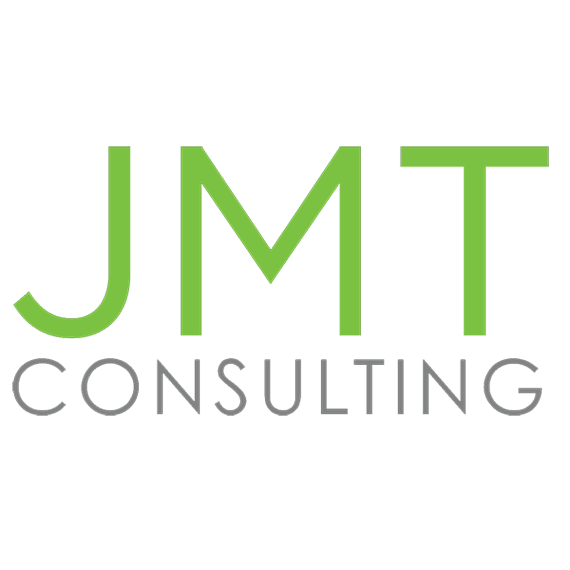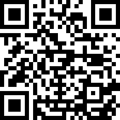
The Nonprofit Show is the nation’s daily live video broadcast for the business of nonprofits — where nonprofit leaders, teams, and changemakers gain practical strategies to strengthen operations, improve performance, and sustain impact.
Each weekday, our Co-hosts and expert guests tackle the most current topics in fundraising, management, marketing, staffing, and technology — all designed to help you run smarter, lead stronger, and deliver on your mission with confidence.
Join our community of nonprofit professionals and explore the real tools and insights you need to build a high-performing organization.
Watch Live. Learn Daily. Lead Better!
Monday thru Friday
Sign-up for Show Reminders!
Meet Our Co-hosts!
Made Possible By Our Generous Education Partners Who Support And Believe In The Work You Do
OUR LEARNING LIBRARY WITH MORE THAN 1,000 EPISODES!
MEET SOME OF OUR FEATURED GUESTS AND EXPERTS

What happens when a kid who scribbles “play soccer at Ohio State” in kindergarten actually does it—and then decides his story shouldn’t be the exception? That question sits at the center of this episode with Channing Chasten, professional athlete and founder of The One Percent Kid Foundation.
From the start, Channing describes a childhood shaped by two steady forces: the soccer pitch and a mother who refused to let academics trail behind. Homework came first, the ball came second. Years later, that same mix of discipline and imagination is now driving a nonprofit built on three pillars: soccer, literacy, and mindset.
Channing explains why he believes in the power of tiny, consistent gains instead of giant leaps. As he puts it, “If you break it down into a small step, you realize starting is the easy part.” That simple idea—1% better every day—guides everything from his youth programs to his fundraising strategy.
We follow his journey through literacy camps where reading comes before drills, turning books into the ticket to soccer practice. He shares what he’s learning about plummeting reading scores, the heartbreaking link between third-grade literacy and incarceration, and why his team expanded from early grades to high schoolers who have already fallen behind.
The story widens as he walks through how he built a board full of nonprofit veterans and soccer leaders, deliberately choosing people who know both the sport and the sector. Their mentoring shapes his ambitions: building a national model starting in Arizona, creating mindset workshops in schools, and eventually launching a scholarship fund for under-resourced students who come through the program.
Along the way, we glimpse the grind behind the dream: chasing grants, securing a city award from Chandler, collecting impact data, filming quality videos so donors can actually see the work, and constantly revisiting big revenue targets in six- and twelve-month windows.
By the end, The One Percent Kid isn’t just a catchy name—it feels like an invitation to kids, donors, and communities to believe that small, steady progress can rewrite a life story.
#TheNonprofitShow #YouthSoccer #LiteracyMatters
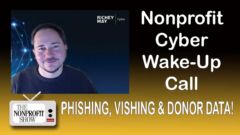
Year-end generosity is a perfect storm for cybercrime—and most nonprofits don’t see the danger until after the damage is done. We talk with Alex Brown, Director of Business Development at Richey May, about why the busiest time of your fundraising year is also one of the most hazardous for your systems, donors, and reputation.
Alex explains how attackers watch for holiday chaos: staff on vacation, rushed year-end gifts, last-minute tax receipts, and overloaded inboxes. “Attackers know you’re not paying as much attention,” he warns, “so you have to be a little extra diligent this time of year.” From fake donation pages to altered bank details, the tactics are increasingly sophisticated—and AI is making fraudulent emails and voice calls nearly impossible to spot by eye or ear alone.
The conversation walks through your “front door” risks, starting with your website and WordPress plugins, then moving into infrastructure scanning tools, outdated software, and weak admin logins. Alex shows why role-based access matters: if every staffer can see and change everything, one compromised account can expose your entire donor database and even your bank relationships.
He also tackles the human side of cybersecurity. Alex explains phishing and vishing in plain language, and why urgency (“this is a one-time exception,” “we need this code right now”) is such a powerful pressure tactic. He urges leaders to replace fear and punishment with ongoing micro-training and a culture where people feel safe admitting, “I clicked something weird.” Silence is exactly what attackers are counting on.
Finally, the episode turns to donor communication. Nonprofits must be crystal clear about how they will and will not contact supporters—what domains they use, which links are legitimate, and what information they will never request by phone, text, or email. Clear expectations protect donors and preserve trust, even if attackers try to impersonate your brand.
This is not a technical luxury; it’s a governance and stewardship issue. If your organization depends on digital generosity, you also depend on digital safety.
#TheNonprofitShow #NonprofitCybersecurity #DonorTrust

Grant writers and fundraisers share the same mission, but often work in different corners of the building—and sometimes entirely different worlds. In this Fundraisers Friday convo, cohosts Julia C. Patrick and Tony Beall peel back the curtain on how these two roles can move from quiet coexistence to true collaboration.
Julia opens with gratitude—for long standing sponsors who have never tried to steer the show’s content, and for a sector that now offers far more professional development than when many fundraisers began. She reflects on her own journey from community fundraising to co-authoring The Architecture of Fundraising with Tony, noting how accessible tools and training could have transformed her early efforts. “I could have raised so much more money for my community if I had been educated,” Julia admits, inviting viewers to keep learning alongside them.
Tony adds his perspective from years in executive leadership, where he saw the strain between event heavy fundraising teams and grant writers tucked away in quiet corners—or now, working remotely. He reminds us that grant writing is both demanding and discouraging work, with many applications never funded despite excellent cases. “We have to find ways to continually celebrate the work that’s being done by grant writers, whether the grant is being approved or not,” Tony says, naming the emotional labor behind every proposal.
Together, Julia and Tony explore how shared language, aligned metrics, and thoughtful use of technology can connect these roles. They talk about separate goals for grants, events, and individual giving, all tied together through dashboards, regular communication, and clear expectations. They even walk through ethical ways to use board and community relationships to support grant applications—without crossing any lines.
In the end, this learning session becomes a gratitude filled call to action: respect each lane, build consistent communication, celebrate the wins, and ensure leadership is championing the relationship between grant writers and fundraisers. When those pieces come together, fund development becomes a unified team effort instead of a quiet, siloed grind.
#TheNonprofitShow #FundraisersFriday #NonprofitFundraising
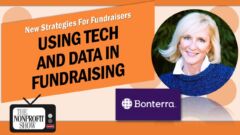
Tech, data, and generosity are not abstract buzzwords—they’re concrete levers that can stabilize funding, expand impact, and re-energize exhausted fundraisers. Chief Fundraising Officer Kimberly O’Donnell of Bonterra joins us to map out how recurring giving, trust-based philanthropy, and AI-powered tools can move the entire sector from scarcity thinking into a new “generosity generation.”
Kimberly starts by reframing recurring giving as non-negotiable infrastructure, not a nice-to-have tactic. As she puts it, “Recurring giving is essential for nonprofit sustainability. Just no, hard stop there.” Bonterra’s own research shows why: in its Meet the Moment report, 58% of federally funded nonprofits report financial instability this year. In that environment, a predictable base of sustainers—monthly and annual—can keep programs moving even as federal funds, disaster response dollars, and one-time grants fluctuate.
She shares a compelling case study: a Bonterra client that introduced three choices on its donation page—one-time, monthly, and annual. By normalizing both monthly and annual recurring options, that organization grew from zero sustainers to more than 65,000, proving that donors will enthusiastically choose ongoing support when invited clearly and confidently.
Kimberly also dismantles the common boardroom fear that sustainers will cannibalize major gifts. In her view, that’s simply a myth. Monthly donors should be seen as high-value relationship partners whose lifetime contributions, planned gifts, and sponsorship potential can grow over time. The real problem isn’t “small monthly donors”; it’s organizations deciding on behalf of donors when and how they will give.
From there, the conversation widens. Kimberly explains how Bonterra’s vantage point—serving nonprofits, community foundations, CSR programs, and public agencies across the social good ecosystem—reveals sector-wide patterns in real time. Trust-based philanthropy, she notes, hasn’t disappeared; it’s evolving. Funders are becoming more intentional, concentrating resources on core pillars while streamlining reporting and using their networks to introduce nonprofits to new corporate and philanthropic partners.
Then comes the big vision: Bonterra’s “30 by 33” initiative to move charitable giving in the U.S. from a stagnant 2.5% of GDP to 3% by 2033. Achieving that shift, Kimberly argues, will require data, AI, and human connection working together—what Bonterra calls the generosity generation.
AI, in particular, is already reshaping daily fundraising practice. Bonterra has been using agentic AI since 2016–2017, and its new tools are built with a “human in the loop” philosophy so fundraisers can test, refine, and own their messages.
Kimberly’s closing message is both empathetic and urgent: acknowledging nonprofit exhaustion yet pushing leaders to resist retreat: this is not a moment to slow down—it’s a moment to experiment, ask bolder questions, and lean on tools that make the work more sustainable.
#TheNonprofitShow #NonprofitFundraising #BonterraTech

Donor love is measurable, and in this lively discussion, guest Lynne Wester, Principal and Founder of Donor Relations Group, brings the receipts. Drawing on data from her seventh global donor relations survey, conducted every two years since 2013 with more than 1,000 participants, Lynne shows us why retention, not the next big campaign, is where the real money is.
Her core message is blunt and refreshing: we obsess over the ask even though it represents a tiny slice of our contact with supporters. As Lynne puts it, “Retention is the secret sauce of fundraising.” Most organizations still pour staff time and budget into events and tactics with weak ROI, while reporting that they are only able to share impact with less than 20 percent of their donors. That gap is not just operational; it is a revenue problem.
The survey findings expose a pattern. Many donor relations teams sit under a mountain of tasks but lack a strategic plan, making them vulnerable to “seagulling” requests that fly in, drop work, and disappear. At the same time, donor relations professionals tend to stay in their roles four to nine years, while frontline fundraisers churn in about 16 months. The people who understand donor experience best often have the quietest internal voice, and Lynne’s work is about giving them data to change that.
She shares how longitudinal data helped the sector mostly abandon donor honor rolls: today, over 80 percent of nonprofits no longer produce donor lists that were costly and not meaningful. The survey is now pushing similar change around giving societies, the split between receipts and acknowledgements, and the use of AI. Lynne is candidly concerned that many organizations use AI tools without organizational policies, even as donor databases at major institutions have been compromised. For her, donor confidentiality and the Donor Bill of Rights demand guardrails before automation.
Perhaps the most poignant remark is Lynne’s insistence that gratitude and listening are not “extras” but performance drivers. Retaining a donor is five to seven times less expensive than acquiring a new one, and organizations that cared for donors as human beings during crises like the 2008 downturn and COVID raised twice as much as those that just kept asking. She argues that if a donor is not “worth a stamp,” the organization does not deserve the gift.
Lynne leaves viewers with a challenge wrapped in encouragement: use data to question tradition, ask donors for their opinions, and treat stewardship as strategic fund management, not a courtesy. When you align technology, policies, and human connection around gratitude and impact, you are not just being nice—you are building a durable, scalable fundraising engine.
#TheNonprofitShow #DonorRelations #FundraisingData
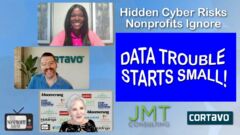
Who actually owns data protection in a nonprofit? In this fast-paced conversation, host Julia C. Patrick sits down with Taysha Adams, Manager Technology Support at JMT Consulting, and Josh Fricovsky, Engineering Director at Cortavo, to tackle the uncomfortable truth: cybersecurity is no longer “someone else’s job.”
Taysha starts with a reality check: most vulnerabilities don’t begin in a server room. They start with everyday behavior. From checking work email on public Wi-Fi to logging in on a friend’s device, casual habits open doors to attackers. As she explains, “Everybody’s responsible for data security and protection… most vulnerabilities do come in from the end users.” JMT has spent more than a year realigning internal processes, tightening device controls, and partnering with Cortavo so their own team—and their clients—are better shielded.
Josh builds on that by showing how fast the threat landscape is evolving. Cortavo’s job as a managed service provider is to sit on the “bleeding edge”: endpoint protection, email security, MFA, VPNs, and now mobile device management for a workforce that increasingly works on the move. He notes that “the cost of inaction is going to be 10 to 100 times more than” the investment in proactive security. It’s not just about tools; it’s about culture, education, and leadership setting the tone.
The conversation then moves to the devices we use every day. Laptops, tablets, and phones are cheaper and more plentiful than ever, but every extra device is another front door. The guests stress that nonprofits need clear policies for using personal phones for work, along with mobile device management to protect company data without “controlling” the phone itself.
AI takes the discussion to another level. Both guests are enthusiastic users, but they warn that unregulated use is dangerous. Taysha urges organizations to set guardrails and favor licensed or enterprise tools so prompts, donor details, and templates aren’t quietly training public models. Josh goes further, recommending offline or private LLMs for sensitive data and pointing out that attackers are already using AI for sophisticated social engineering, including voice cloning and real-time credential theft.
Finally, the trio frames cybersecurity as a governance and financial issue, not just an IT problem. Data loss can mean lost clients, destroyed reputation, and even the end of an organization. Partnering with firms like JMT and Cortavo, building internal awareness, and treating security like an essential protection policy—not a luxury—are presented as non-negotiable steps for modern nonprofits.
This episode is a must-watch for executives, boards, and staff who touch data in any way—which is everyone.
#TheNonprofitShow #NonprofitCybersecurity #DataProtection
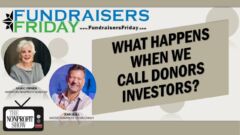
What if the people we call donors are actually investors? And what if this subtle shift reshapes expectations, power, professionalism, and even the identity of philanthropy itself? Julia C. Patrick and Tony Beall challenge one of the nonprofit sector’s most deeply rooted labels.
Julia opens the conversation by admitting she’s ready to change her own vocabulary, saying, “I’m going to really work hard to say investor, because I think you’re right—this is the way we need to go.” Her candor sets an energetic tone for a conversation that questions long-held nonprofit norms while encouraging fundraisers to rethink the relationship they build with contributors.
Tony expands on how much the terminology already shapes his practice. “It’s pretty much standard for me now to speak of donors as investors,” he explains, noting that while the marketplace may not fully be prepared for the switch, fundraisers can begin reframing relationships in ways that strengthen professionalism, transparency, and long-term engagement.
The conversation provocatively asks whether “donor” — rooted in the Latin donare, meaning to give — unintentionally implies release, relinquishment, or even detachment. Meanwhile, “investor,” drawn from investire, meaning to clothe or furnish power, places the contributor inside the organization’s journey, not on the sidelines.
From this vocabulary shift springs a lively exploration of expectations. A donor may hope the gift “does good,” while an investor wants measurable progress, long-term capacity building, and consistent communication tied to real results. That distinction pushes nonprofits toward better data, better systems, and better reporting.
Julia and Tony also discuss how this reframing could meaningfully influence recruitment and retention in the sector. Elevating the profession with language rooted in strategy and expectation — not charity alone — may attract more skilled talent while giving current fundraisers a clearer sense of the complex, meaningful work they perform.
They later explore generational dynamics. Older supporters may lean toward benevolence. Younger supporters are far more metrics-driven, tech-oriented, and impact-focused. For next-gen philanthropy, “investor” may simply feel more accurate.
The informative convo closes with a practical comparison using a $5,000 gift to a food bank. A donor experiences satisfaction and goodwill. An investor expects data: pounds of food purchased, households served, meals distributed. The contrast illuminates how terminology drives operational behavior.
By the end, the case for shifting language becomes both philosophical and functional. It’s a lens that prompts nonprofits to strengthen systems, build trust, and engage contributors more meaningfully — all while honoring the emotional roots of giving.

Federal shutdown over! Systems rebooting! Nonprofits on the clock! In this urgent episode, we bring back Derick Dreher, Department Leader, Government Funding at Your Part-Time Controller (YPTC)—just hours after the government reopens from the longest shutdown in U.S. history.
Derick starts with what happened in Washington: failed Senate votes, a last-minute continuing resolution, and a deal that funds government operations into January while restoring budgets for agencies like USDA and programs such as SNAP. But this is not just a civics lesson; it’s a compliance wake-up call for every nonprofit with federal awards.
Even though agencies were closed and portals were offline, he reminds viewers that obligations never went away. As Derick puts it, “It’s a challenge, but you still have to do it.” Reports due during the shutdown are still due. If a federal portal was off, organizations should have emailed, mailed certified copies, and documented every step. That paper trail may be the difference between a simple explanation and a “you’re in breach” notice now that systems are back up.
Derick explains that rules are shifting at the same time pressure is rising. An August executive order on federal grantmaking is reshaping Uniform Guidance and, in some cases, contradicting existing regulations. Nonprofits cannot simply move programs from October to November or rework budgets on their own. Any change—timelines, program design, vendors—requires permission.
The human side of this story is just as urgent. Federal employees returning from 43 days of furlough are staring at thousands of unread messages, while agencies are already dealing with staffing shortages. Automated payments and notices may resume quickly, but nuanced approvals, extensions, and clarifications will take time. That means nonprofits must expect delays while still operating at peak year-end demand and navigating food insecurity, SNAP disruption, and stretched donors.
Derick calls on leaders to treat this as a mini audit moment: review every award, update budgets and reports, clarify what did and didn’t happen during the shutdown, and then proactively request extensions and changes. “Federal awards are complicated beasts that have a lot of details and a lot of moving parts, and there’s no reason to be afraid of accepting them,” he says—if leaders build strong internal controls for timesheets, receipts, and documentation.
Above all, think of this as a reframe of the relationship with government funders: not as begging with an outstretched hand, but as a handshake partnership where authenticity, preparation, and transparency show you are leading with excellence. Get organized now, communicate wisely, and you can turn this chaotic shutdown into a proving ground for your nonprofit’s strength and mission focus.
#TheNonprofitShow #NonprofitFinance #GovernmentGrants
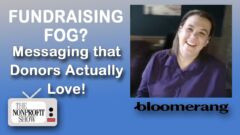
Fundraising can feel like walking through mist—messages blur, instincts wobble, and urgency crowds out intention. In this energizing conversation, we welcome returning favorite Micah James (team lead and coach at Bloomerang—and a bride-to-be!) to name the haze and show practical ways through it. Micah calls today’s moment “muddy and foggy” because donors face nonstop alerts, shifting giving channels, and rising skepticism about how funds are used. Organizations feel it too: higher costs, greater need, and inboxes stuffed with appeals that all sound the same.
So what cuts through? First, stop centering money and recenter mission. As Micah says, “We don’t want to give to budgets…we want to give to people, to mission, and to impact.” Translate dollars into outcomes. “There’s nothing wrong with saying we’re raising $3,000 because it will feed 300 families”—pair the cost with the change. Then make it personal. Tell one vivid story (Stacy, Jim, or Larry), not vague totals. Shift language so the donor becomes the hero; use “you” as often as “we.” That mental switch alone sharpens your message and steadies your strategy.
Micah urges radical transparency to build trust. Be clear about what it takes to serve and honest when you’re not top-of-mind in the community. Share the real work and the real budget picture without panic language. Invite support in many forms—gifts, volunteer hours, or simple acts of advocacy—and keep communicating the difference each supporter makes.
A big unlock is specificity. Use your database tools to reference the donor’s last gift and show what it accomplished. Celebrate recurring givers and ask for modest step-ups (from $10 to $15, from $47 to $60). Those small upgrades flatten chaotic cash-flow lines and reduce the pressure that pushes teams into constant alarm. Micah reminds us that the often-forgotten “middle” donors—already engaged, steady in capacity—can become the backbone of predictable revenue when you know them well and speak to what they care about.
Bottom line: name the fog, then choose clarity. Tell one true story. Make the donor the protagonist. Map dollars to outcomes. Share the journey openly. When you do, the sun breaks through—and sustainable generosity follows.

Nonprofits can absolutely finish the year strong—especially when they treat staffing as a strategic tool, not a scramble! In this energizing convo, Katie Warnock, founder and president of Staffing Boutique, maps out practical ways organizations can add capacity right when it matters most. Katie is plainspoken and solution-oriented: for major fundraising events, she recommends planning eight to nine months out and matching roles to real workload. “First of all, if you don’t have an events director, get one. If that’s not feasible, bring in a seasoned temp events director or an events manager to handle day-to-day logistics.” That approach keeps development leaders focused on relationships and revenue instead of table charts and coat checks!!
Katie outlines flexible staffing ramps—lighter hours early, surging near event day, then tight close-out to ensure donations, acknowledgments, and data entry are flawless. She is equally direct on year-end donor support: bring in skilled database professionals familiar with your CRM to process gifts fast and accurately. Volunteers are wonderful, but gift integrity demands pros.
Volunteer management gets a reality check. Holiday enthusiasm is great, but sustained help across the calendar—June, August, February—changes outcomes. Katie urges orgs to capture individual contacts from corporate volunteer days and cultivate them directly; today’s 22–32 year-olds become tomorrow’s major donors and often bring corporate dollars with them.
Looking beyond December 31, Katie champions prep projects that set teams up for a calm, effective new year: digitizing archives, standardizing folders and calendars, and documenting processes. She even shares a personal productivity win: embracing AI to tame an overloaded inbox. “Embrace AI… it’s here and it’s making so many things so much easier.” Finally, she models healthy team norms—blocks of focused work, breaks for movement and sunlight, and clarity on priorities—so coverage feels near 24/7 without burning people out.
Bottom line: think earlier, staff smarter, protect data, convert volunteers to champions, and set up systems now so January starts smooth. With the right mix of temps, consultants, and clear processes, your organization can thrive through year end and launch into the new year organized, energized, and ready to grow.

In this capstone to Nonprofit Power Week, Rita L. Soronen, President and CEO of the Dave Thomas Foundation for Adoption, looks forward—past the news cycle and into the work that will shape children, families, and the sector. In a calm, mentoring tone, Rita keeps leaders grounded in first principles: start with the child. As she puts it, “We’re not finding what child is best for a family, we’re finding what family is best for a child.” That mindset reframes recruitment, kinship care, and inclusion, and it calls leaders to stretch their own practices.
Rita shares how public attitudes toward foster care and adoption have matured, yet can backslide when sensational stories appear. Her counsel: hold firm to truth, trauma awareness, and mental health supports. She offers a practical compass for politicized climates: begin where everyone can agree. “Anyone here who’s ever been a child, please raise your hand… We have to bring it back to what’s best for children.” From there, leaders can convene consensus, reduce noise, and invite real collaboration across agencies, movements, and communities.
On funding and donor behavior, Rita maps the changing landscape—fewer donors, larger gifts, and strong interest in measurable impact and systemic change. The lesson for leaders is balance: keep legacy channels available while building digital fluency and fluency in donor-advised funds, non-cash assets, and planned giving. Pair that with scenario planning so your organization is resilient when markets, tax policy, or public health winds shift.
Rita’s advice on next-gen leadership is both warm and direct. Embrace impatience for progress, mentor toward mastery, and translate across generations. Model curiosity over eye-rolls; teach how boards govern, how budgets work, and how durable change is built—without dampening the urgency younger leaders bring.
Finally, Rita urges courage without fear. Hold your mission steady when funding anxieties rise. Convene unusual allies. Keep articulating the value of childhood, permanency, and family—then amplify shared ground loudly. Leaders who do this will guide teams and donors through uncertainty and keep children at the center, where they belong.
#TheNonprofitShow #Adoption #FosterCare

The Dave Thomas Foundation for Adoption shows exactly how today’s nonprofits can accelerate mission and amplify revenue by putting marketing and development on the same team! CEO & President Rita L. Soronen and SVP of Marketing & Development Jill Crumbacher explain how an approach that started 11 years ago matured into an integrated structure with shared goals, clear ownership, and board alignment. As Rita puts it, “there’s just this intuitive sense…that one feeds the other,” adding that the shift “became very much an organic, ongoing conversation based on results.”
Jill brings for-profit rigor to the model: a VP of Marketing and a VP of Development co-lead paired “mini teams” for every fundraising channel, tracked in Asana with crystal-clear metrics. “Building a brand builds fundraising and building fundraising builds a brand. It just does,” Jill says. She adds, “For every fundraising team, we have a marketing team that supports the fundraising team”—a simple but powerful mechanism that reduces friction, speeds execution, and raises standards across content, design, and segmentation.
Rita details how leadership benefits from unified messaging: presentation materials, program context, and donor narratives are synthesized by one group that also collaborates tightly with program staff. She emphasizes stewardship and brand guardianship: “we’re not just protecting the brand of children in foster care, we have Dave Thomas in our name… We’re protecting that brand as well,” including the Foundation’s decades-long partnership with Wendy’s. The conversation also takes on today’s polarized climate. “We’re putting resources into the effort of how do we bring polarized conversations back together?” Rita notes, reinforcing the Foundation’s focus on solutions that broaden support without losing mission clarity.
Talent development is intentional. Jill shares how their marketers attend the Lilly Family School of Philanthropy to learn fundraising dynamics, while fundraisers learn marketing language and channels—so both “come out of the same gate.” The approach scales: the department grew from a handful of staff to 25, roughly split between development and marketing, with half of marketing embedded on fundraising squads and half focused on awareness, brand, and sector thought leadership.
The result is a disciplined, collaborative culture that moves faster, communicates smarter, and raises more—while advancing permanency for children in foster care.
#TheNonprofitShow #Adoption #NonprofitLeadership
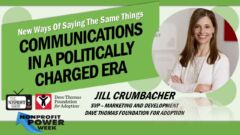
Nonprofits are being yanked into culture wars they never asked for. In this Nonprofit Power Week conversation, Jill Crumbacher, Senior VP of Marketing and Development at the Dave Thomas Foundation for Adoption, lays out how to keep your message steady when the public square gets noisy. This episode is a field manual for keeping your purpose intact—and your voice effective—when the temperature rises!
Jill’s team spans both marketing and fundraising—by design. As she puts it, the Foundation treats the whole enterprise “as one big communication strategy,” where audience segmentation, message discipline, and timing live in the same room.
Are foster care and adoption political? Jill’s answer: yes—and no. The Foundation operates at the back end of the process, after courts determine a child cannot safely return home. That’s where “finding forever families” becomes the mission—while the front end (why a child enters care) is where debates about poverty, racism, and systems flare. That nuance matters, and Jill’s team crafts language for each audience: “adoption” for the public; “permanency” for child-welfare professionals who also consider guardianship and reunification.
Jill’s playbook mixes discipline with restraint. She says it plainly: “Just because a reporter calls you doesn’t mean you have to reply.” Years before headlines heat up, her team works with crisis-comms experts to pre-write long and short answers for likely “arrows”—from Dobbs to immigration—paired with a decision tree about whether to engage at all. The goal is to protect mission focus when others try to conscript your voice for their fight.
Inside the house, rigor rules. The comms calendar is “beautifully organized chaos,” mapping channels, suppressions, and variants for donors (new, returning, Wendy’s-affiliated, etc.), followers, and child-welfare audiences. Message control isn’t censorship; it’s service to clarity. The team maintains a “say this, not that” lexicon and sends materials to outside reviewers to catch phrasing that could be misunderstood in other contexts.
There are also non-negotiables. “We will celebrate all children and we’ll advocate for all children in the system, regardless of how they identify,” Jill says. The Foundation’s images and words stay consistent year-round—they don’t “poke,” they persist. And when criticism pops up, they’ve seen the community often step in first, defending the work organically on social media.
If you steward a mission in a volatile moment, borrow these moves: define your lane, choose words precisely, prepare answers in peacetime, monitor hot-button issues for possible linkages, and decide in advance what you will never trade away.
#TheNonprofitShow #FosterCare #CrisisCommunications
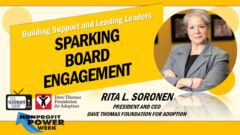
In this key conversation, Dave Thomas Foundation for Adoption President & CEO Rita L. Soronen maps out a modern playbook for governing with purpose while sustaining momentum after years of change. She begins with the Dave Thomas legacy—not as a branding exercise, but as a lived journey that shaped a national public charity with a singular focus: permanency for children in foster care. “If you can do one good thing in life,” Rita reflects, “the fact that he created two iconic brands—the Wendy’s Company and the Dave Thomas Foundation for Adoption—is just remarkable.” That origin story still informs board design, revenue strategy, and leadership cadence today. The throughline for governing is respect for leaders’ time and a culture where advice is welcomed, staff are empowered to execute, and collaboration fuels outcomes for children and families.
Rita details a deliberately blended board: seats for Wendy’s C-suite leaders (tone from the top), franchisees who steward restaurant-level campaigns, Thomas family members, and public members—researchers, policy experts, legal leaders, and child welfare practitioners—who bring depth to complex decisions. The result is governance that can guide a mission working at local, state, and federal levels without being mistaken for a corporate foundation. “We want donors to see a public charity doing serious work,” she notes, “and not assume we’re fully funded by Frosty sales.”
Her approach to engagement is disciplined and human. Board meetings are two in-person and two virtual per year, each paired (for the in-person sessions) with intentional social time to build trust. Meetings themselves are crisp—two and a half hours—because the real work happens in committees that meet quarterly, report out, and keep decisions moving. Between meetings, Rita runs a high-touch communication rhythm: January one-on-ones with every director, timely updates to the executive committee, and monthly check-ins to prevent surprises.
On fundraising, she favors shared responsibility over quotas: franchisee-driven campaigns; a gala at Wendy’s convention; personal giving from all members; and thoughtful introductions to new corporate and individual partners. Equally important is recognizing non-monetary value—when a board member’s policy expertise or research acumen is as catalytic as a major gift.
Finally, Rita describes their operational maturity: a formal platform (Nasdaq Boardvantage) for materials; a consent agenda; predictable deadlines; and smart seasonality—virtual meetings in December and June to avoid travel disruptions.
#TheNonprofitShow #BoardGovernance #Adoption
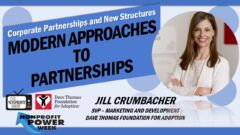
The Dave Thomas Foundation for Adoption doesn’t treat partnerships as a side project—they’re the operating system. During this National Adoption Month and in this Nonprofit Power Week kickoff, Senior VP Jill Crumbacher shares how the Foundation builds relationships that move from a good idea to real results. Step one: align the people doing the work. “Our marketing and our development practice is under one department that I lead,” Jill explains. That single team design means awareness and revenue aren’t competing—they’re collaborating—so a PSA, a billboard, a direct-mail test, or an influencer post can ladder up to the same mission outcome.
Jill dismantles the common myth that Wendy’s alone funds the mission. Wendy’s is a long-standing, values-matched partner, but the need—kids and teens waiting for family in the U.S. and Canada—calls for many hands. That’s why DTFA manages a wide mix of partners each year: micro-influencers and media outlets, cause-aligned brands, and fundraising collaborators. To keep everything clear and friendly, they start with the right agreement for the moment—an approachable MOU for brand exchanges and content support; a fuller contract when dollars or large placements are involved. The paperwork isn’t red tape—it’s a map. Who does what, by when, with what approvals. Everyone can move faster because expectations are written down.
Media is changing, and the Foundation adapts. Donated placements are still vital (think PSAs across billboards, airports, radio, and connected TV). But there’s also a growing middle lane Jill calls “low bono”—discounted inventory that isn’t free but is far below market. The team buys when the data says it’s smart, especially in digital, and pairs that with donated reach for scale.
Brand care is a shared responsibility. The Foundation reviews language and usage to protect its name and the Wendy’s connection. If something flares online, they pick up the phone so partners aren’t blindsided. That builds trust, and trust keeps doors open. Multi-year deals? They’re great when they make sense, but Jill’s team prefers to earn renewal through value rather than lock people in. The relationship stays fresh because both sides want to come back.
Maybe the most refreshing part is Jill’s take on celebrity. The organization has tested it; the results weren’t lasting. The real wins come from people and brands who show up because they truly care. As Jill puts it, “You go further with the ones that are organic… when you’re all in it about the mission.” Those partners bring energy, introduce new allies, and help the message travel farther.
If you’re rethinking how your organization shows up with partners—how you set expectations, share brand space, blend donated and paid reach, and keep everyone rowing in the same direction—this conversation is a ready-to-use roadmap for doing it well, and doing it together.
#TheNonprofitShow #AdoptionMatters #NonprofitPartnerships

